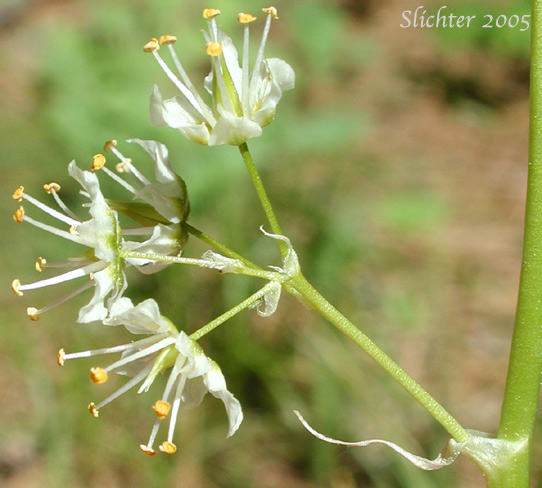 The
photo at right shows a close-up of one of the lower branches of the panicle of
panicled death-camas as seen on Mt. Adams........June 2005.
The
photo at right shows a close-up of one of the lower branches of the panicle of
panicled death-camas as seen on Mt. Adams........June 2005.
Panicled death-camas is a beautiful but deadly lily. It is typically a single stout stem arising from 30 to 50 cm from a tunicated bulb. The linear leaves have parallel venation and are on the stem, but at its base. Those leaves found higher on the stem are much reduced in size. The longest leaves are 15 to 40 cm long and 3 to 12 mm wide.
The inflorescence is paniculate, although the upper flowers may be racemose. This means the lower panicles are clusters of flowers coming off the stem, while the upper racemes would consist of single flowers coming off the stem. The inflorescence is much longer than in Zigadene venenosus, ranging from 10 to 30 cm in length. The tepals are white or cream color. The flowers are mostly perfect, although occasionally the lower flowers may be staminate.
As mentioned above, this plant is deadly to ingest. It is sometimes found interspersed with the edible camas, and native tribes often removed it from the camas beds while both were in bloom, as the bulbs of both are similar.
Panicled death-camas may be found living in sandy or rocky areas to meadows often interspersed with sagebrush.
Panicled death-camas is commonly found from the Pacific Coast inland to the Great Plains, north into British Columbia, and south to Baja California.
In the Columbia River Gorge, panicled death-camas may be found between the elevations of 100'-1200' from near Catherine Creek east past Biggs, OR.
The photo at left shows a close-up of the inflorescence of panicled death-camas. On this species, only the upper branches of the inflorescence might bear single flowers, while meadow death-camas is largely a raceme, with all branches of the inflorescence bearing single flowers, although occasionally, the lowermost branches may bear 2-3 flowers. The photo at right shows panicled death-camas blooming on open slopes above the Crawrod Oaks Trailhead at Columbia Hills Historical State Park.....March 24, 2022.